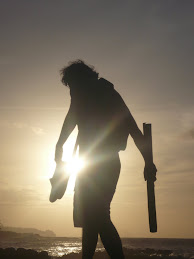Mapping a site is a basic skill that is essential to permaculture design; it is the 'Point A' from which the design process starts.
Photo: Students map the homesite in the ground.
Students split up into teams and walked the teaching site (we are being hosted in the home of Talek, one of Ifira's best rugby players) to pace the boundaries, and gain a hands-on experience of drawing a site map to scale.
After everyone had sketched rough maps in their notebooks, we gathered again as a group and consolidated the information gathered to create a 3-D map on the ground.
In this way participants could share & discuss the information each had gathered, and discover each other's different perceptions of the same site. This interactive group process also serves to engage multiple learning styles and cross language barriers, creating opportunities for teams to start learning from each other instead of relying upon a translator to convey the entire lesson - not everyone can learn effectively in a lecture format in their own language (let alone having to sit through a translated 90-minute lecture).
Photo: Class discussion to map external energies acting upon the site.
Once the class had transferred the information gathered to create the larger-scale map on the ground, we could map the external energies which impacted the site - what we refer to as 'Sectors' in permaculture design.
As the group discussed prevailing winds, solar aspect, foot traffic, water flow across the site, and hurricane risk, it became apparent that it would just make sense to place certain elements in certain places (for example bananas in the lee of a structure to give it protection from hurricane winds).Photo: Student map.
Next we explored how use patterns will affect design decisions made for the site - what we refer to as 'Zones' in permaculture design. Since the bathroom, kitchen & pigpen are all areas which are visited daily, we can take advantage of these energy flows to place what we need most often along these paths.
If we plant fruit trees along these flows, we can monitor them daily on our way to where we need to go anyways. Or back at home in Hawaii, we may choose to site our herb garden outside the kitchen door (or even inside the kitchen if we are especially creative!).

No comments:
Post a Comment